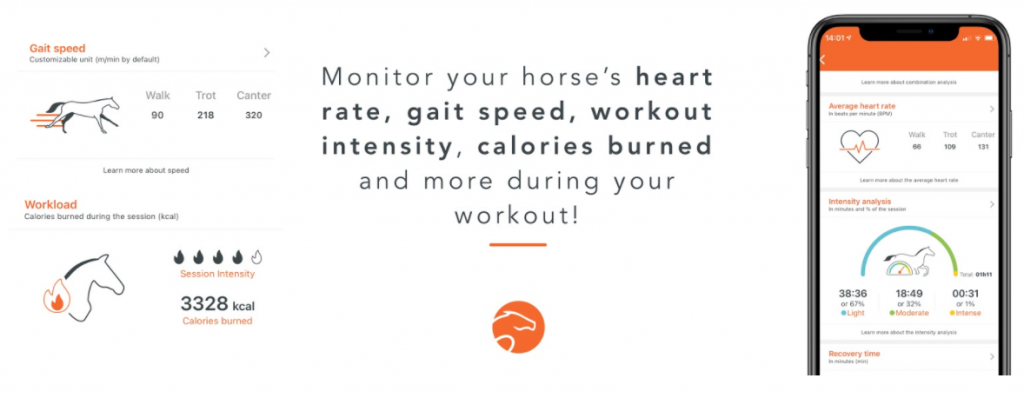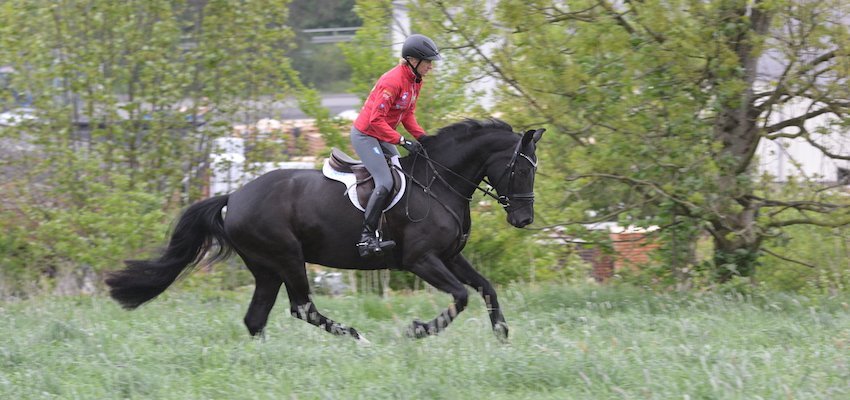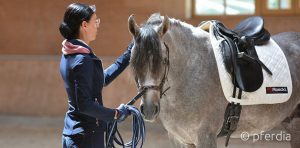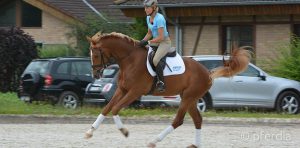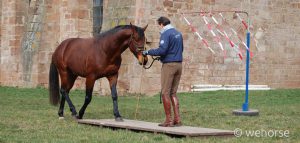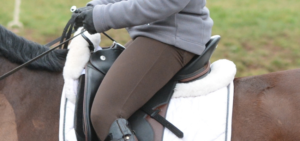Interval training has been used by athletes as a training method for centuries and there is a very good reason as to why this is. The first form of interval training is said to have been developed by the Hitties (great horseman) who lived around 1600 to 717BC. Back then, they used this type of training to train their chariot horses so that they could travel for long distances at high speeds. Nowadays, however, it is used in many areas of equestrian, but most commonly in eventing and endurance. This is because high levels of stamina are required.
In this article, we will dive into the world of interval training and also provide you with tips and exercises which you can perform with your horse.
Summary
- What is Interval Training?
- Why is it Important?
- Benefits of Interval Training
- How to Successfully Complete an Interval Training Session
- The Dos and Don’ts of Interval Training
What is Interval Training?
Before we get started on the why and how of interval training we must first understand what it actually is.
By definition from Oxford Languages, Interval Training is “physical training consisting of alternating periods of high- and low-intensity activity.”
When we break it down, this means that interval training is a workout which is structured by alternating short, high-intensity bursts of speed/power and slower recovery phases. These two phases are completed several times in one single workout.
The aim of this type of workout is to improve your horse’s anaerobic threshold by training their system to work as long as it can. The anaerobic threshold is the highest intensity that your horse can sustain for a long period of time without a large lactic acid build up (The body makes lactic acid when it is low in the oxygen it needs to convert glucose into energy). This means that by using interval training to push the anaerobic limits of your horse, they will then be able to exercise for longer before they reach their point of fatigue.
If your horse is forced to complete a long period of intense activity with no period of rest, they will get fatigued. Therefore, in order to be able to complete interval training successfully, you need to ensure that you only do intense levels of activity for a short period of time so that your horse has an adequate amount of time to rest.
In technical terms, if you allow your horse’s pulse rate to drop back to almost normal rate while they are resting, then, just before they reach their complete normal pulse, go back into your intervals, this will allow your horse to strengthen their muscles, heart and lungs.
Doing this means that your horse will learn to adapt to the stress which is placed on them, thus meaning they will learn to cope with the exercise better the next time.
Now that we understand how interval training works, it is important to ensure that we perform the exercise correctly. The easiest way to measure this will be to equip yourself with a heart-rate monitor. By using this technical tool, you will be able to see your horse’s heart rate in real time while you are riding. This means you will be able to monitor when their heart rate goes down so you can pick the perfect time to go back to your intense training.
Why is it Important?
Scientists still haven’t quite figured out why interval training improves anaerobic performance more than other types of workouts. However, we can assume that it has to do with your horse’s ability to pump blood to their heart.
By exercising in general, you are increasing your horse’s fitness, which in turn increases the amount of blood which comes out of their heart. When performing interval training, you are increasing your horse’s heart stroke volume even more. (Stroke volume is the amount of blood which comes out when the heart is contracted).
Keeping all this in mind, it is simple to think that by increasing the amount of blood which is pumped to your horse’s heart, it will allow your horse to perform better, especially under pressure in competition.
Benefits of Interval Training
There are numerous benefits when it comes to interval training. Least to say that it does not only save you time but also will be kinder on your horse!
1 – Faster and More Efficient Workouts
If you don’t have much time, interval training is a great timesaver! It allows you to get a lot done in a shorter period of time as you can complete a full workout with your horse in less than 30 minutes.
2 – Reduced Risk of Injury
By now we know that interval training means that you vary the intensity of your ride. Because of this it means you may be able to avoid injuries or overtraining your horse as compared to with longer workouts.
Keeping this in mind, it is important to always remember the physical condition of your horse and pair that with the intensity level of your training session.
For example: If you are just bringing your horse back into work after having 2 months off, we recommend that you start slow. For instance, if you would like to do some interval training, start with short amounts of slow canter, pairing that with longer intervals of trotting or walking.
Doing this will allow your horse to be able to increase their endurance and fitness at a steady pace which will in turn minimise muscle soreness and even the possibility of injury.
3 – Increased Endurance
Interval training actually trains your horse’s heart to pump more blood to all their muscles while extracting that oxygen more efficiently. This means that it will make all their other workouts easier for them!
4 – Weight Loss
Numerous studies[1] show that interval training, even at a moderate intensity, may burn more fat and will continue to go on to burn plenty of calories after it is completed as well. Therefore, if you’re looking for a time efficient, highly effective workout (especially if you want your horse to lose some weight) this is the workout for you!
The best way to do this is to measure the calories your horse burns with an appropriate tool and then monitor their feed intake accordingly!
5 – It’s Fun!
Due to the time efficiency of interval training, it will prove to offer more variety to your training session and it also may make it less boring for your horse.
It is also a great excuse to get out of the arena and have some fun in the paddock!
[1] The One Minute Workout: Science Shows a Way to Get Fit That’s Smarter, Faster, Shorter by Martin Gibala.
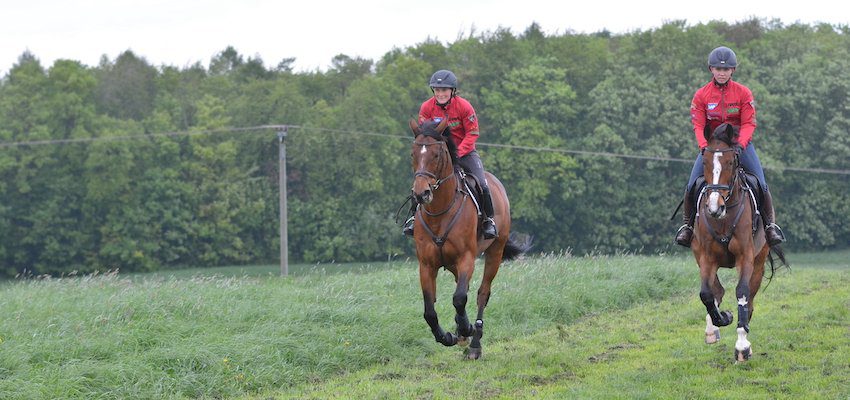
How to Successfully Complete an Interval Training Session
1 – Choose the appropriate tool to accompany your training
Complete the interval training in a lesson with your coach or have an appropriate sensor so that you can record your session and analyse your data afterwards.
2 – Choose an appropriate area to complete the workout
We recommend that you find a space depending on what kind of interval training you want to do. Utilising hills is a great way to increase the difficulty of your session or you can also do it on the flat ground.
Make sure either way that you check the area for holes in the ground to ensure that your horse will not trip and injure themselves during your workout.
3 – Choose the length of your workout
The time of the workout will depend on the fitness level of your horse. It is very important to talk with your coach and/or vet to see how fit your horse is before you start interval training. Once you have talked to your coach and/or vet you can choose an appropriate duration accordingly. You must then choose the length of time where you will be at high intensity and rest.
For example: if your horse has a low level of fitness (ie. If your horse has a heart rate bigger than 130bpm on a slow canter during warm up), you might want to alternate 1-2 minutes of higher intensity exercise with 5 or more minutes of lower intensity. If your horse has a high fitness level then you may choose to have 10 minutes of higher intensity exercise with 2 minutes of lower intensity.
All these numbers are completely up to you, find a good balance which works for you and your horse and during the intensities. Try to maintain a steady pace so that your horse can reach a steady heart rate and make sure that you complete each interval in both directions!
See below the table of examples to assist you:
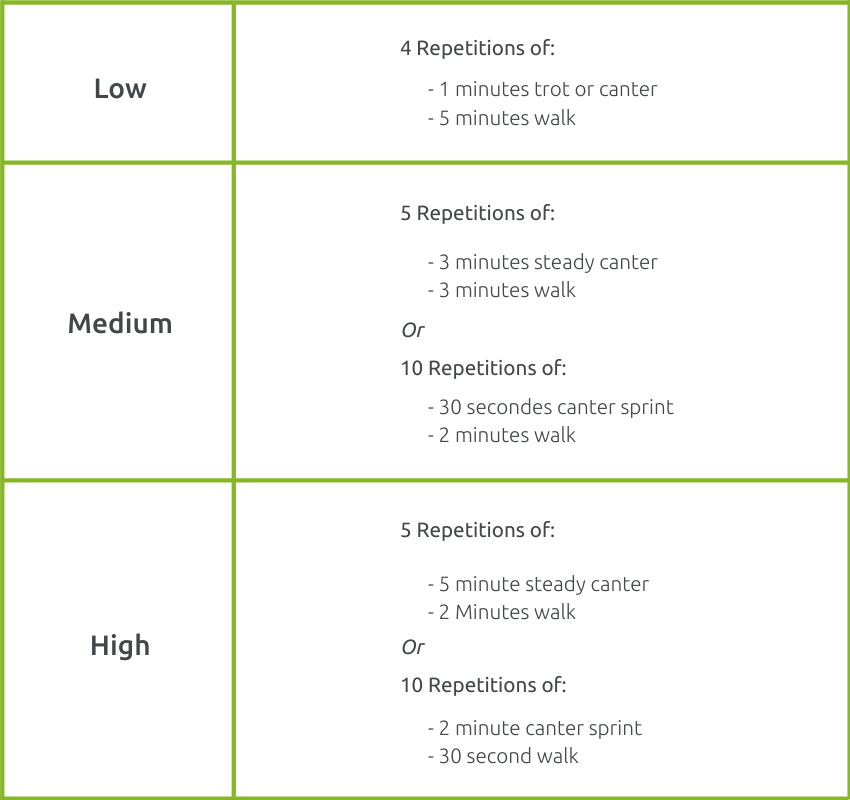
The Dos and Don’ts of Interval Training
DOs:
- DO move faster. Make sure that you go significantly faster during your high level intensity than the low. This will ensure that you are creating a proper gap in heart rate between the two variants of work and therefore you will maximize the effectiveness of the workout.
- DO incorporate this type of training at least once a week into your training regime, especially if you ride endurance or eventing.
- DO warm-up and cool down properly after your workout. This will allow your horse’s muscles to adjust accordingly and prevent any injuries.
- DO monitor your training with a fitness tracker, such as the Motion S so that you can monitor your horse’s performance accordingly and minimize any injuries or lameness.
DON’Ts
- DON’T practice interval training on consecutive days. This type of training is intense for your horse and requires an adequate amount of time to recover.
- DON’T perform this type of workout if your horse has just had a hard feed. Wait at least one and a half to two hours so that your horse has had enough time to fully digest his meal.
As we can see from this article, interval training assists your horse to increase their respiratory and circulatory system capacity. By doing the above-recommended exercises, you will strengthen your horse’s heart which will enable them to pump more blood around their body. This means that they will then be able to provide their muscles with more oxygen more efficiently, thus delaying the anaerobic phase.
In conclusion, we can see that interval training is one of the most effective training methods. If it is done correctly with a proper training plan and the right monitoring tool, it will be very successful for your training as well as beneficial for your horse’s long term health!
We recommend the Equisense Motion S which is a great tool that tracks your horse’s heart rate, calories burned, rhythm, symmetry and also has a GPS tracking system.
